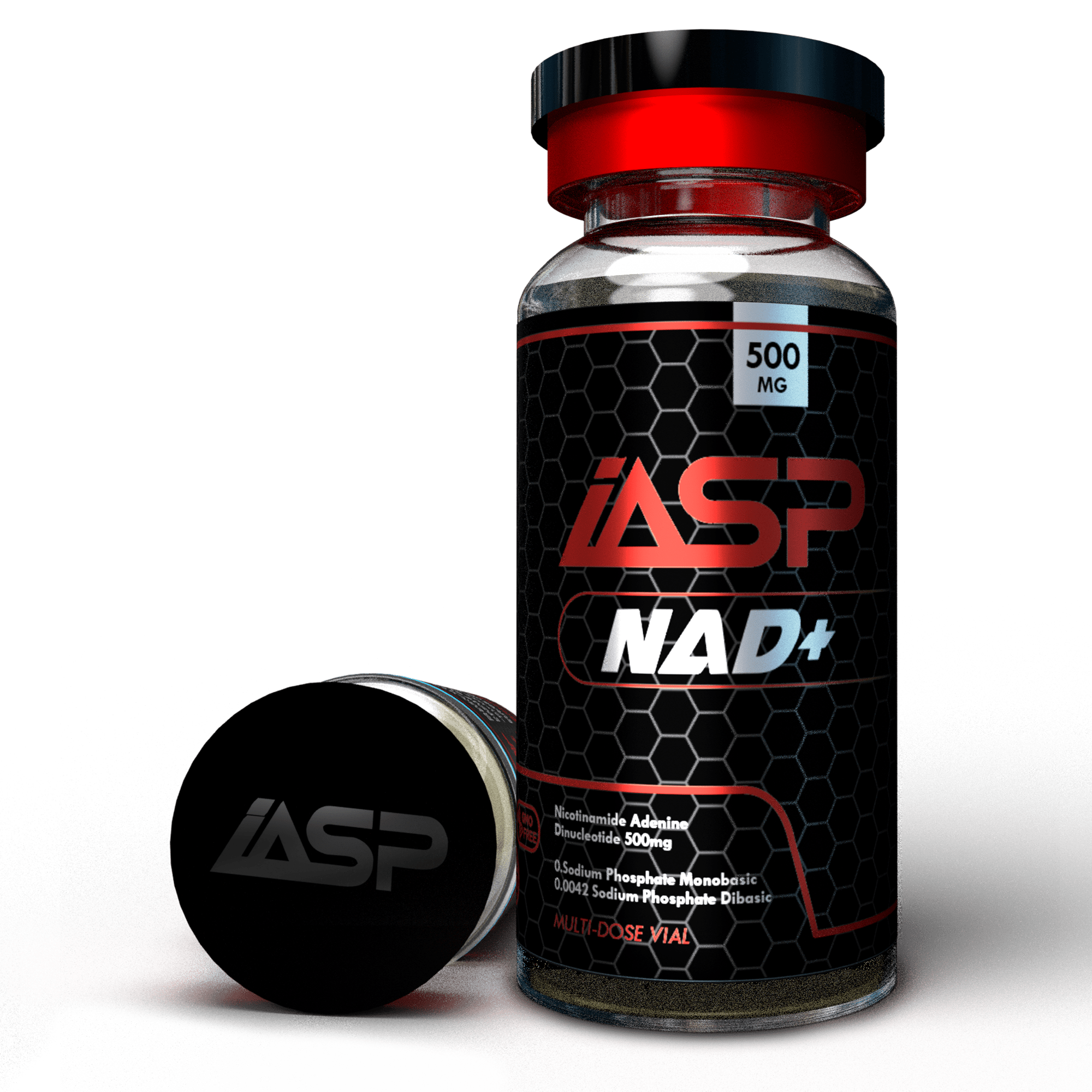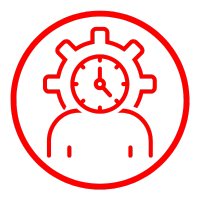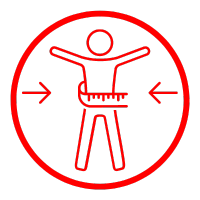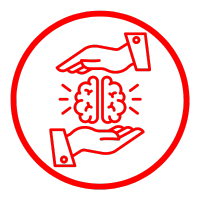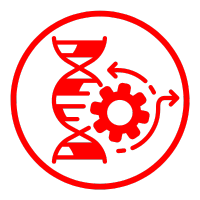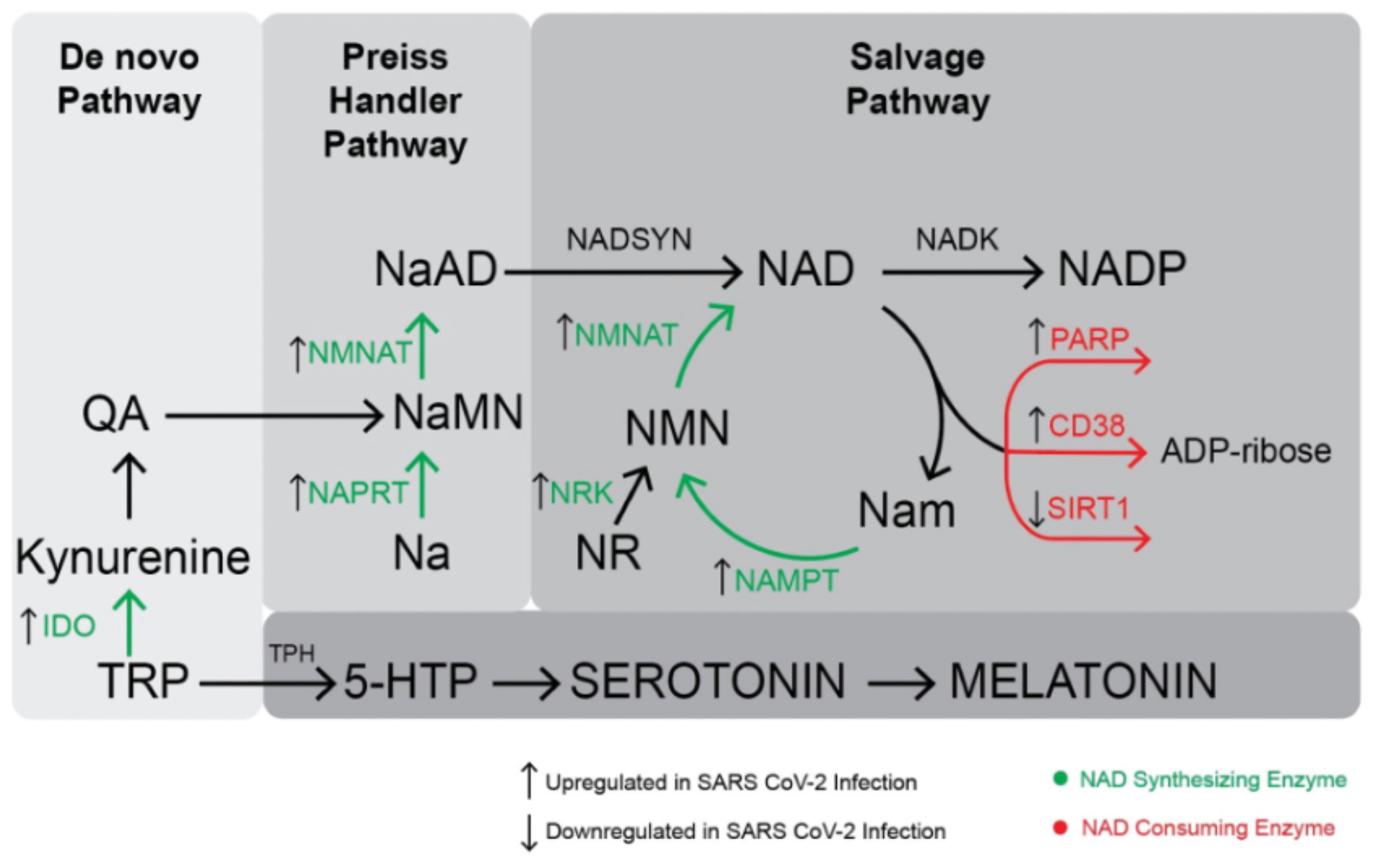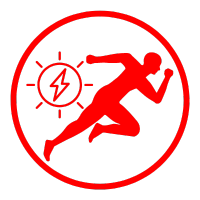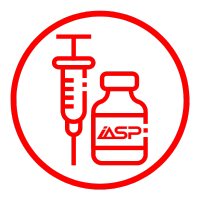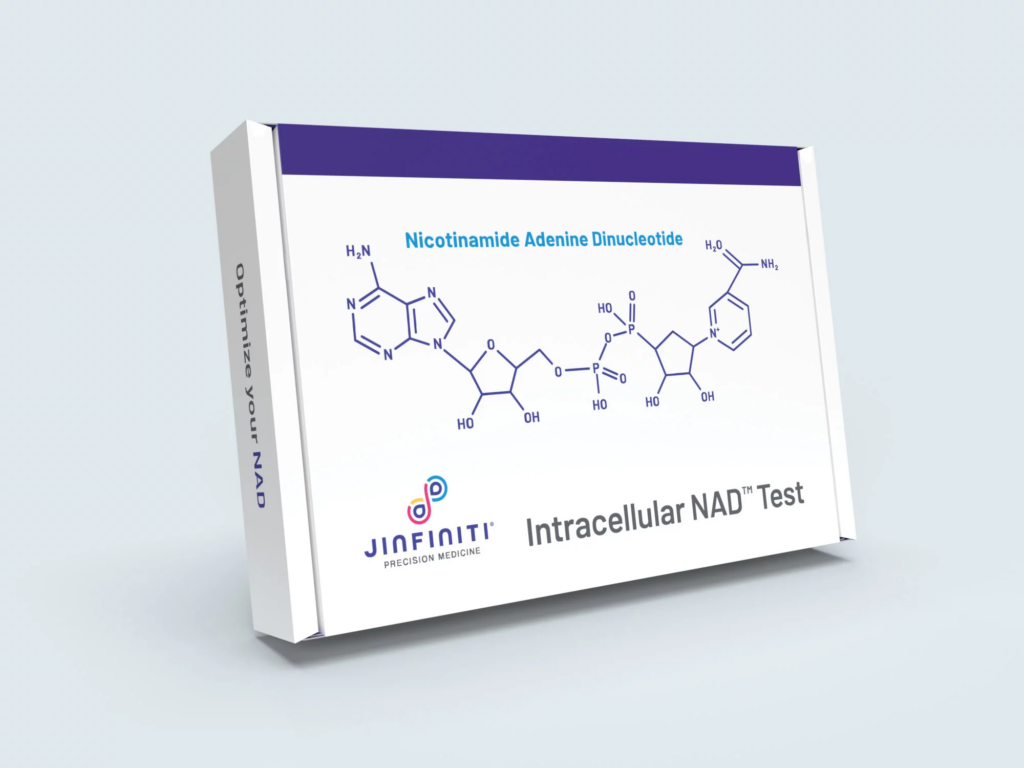This product is a box of 10 vials.
NAD+ THERAPY
IN YOUR OWN HOUSE!
WHAT IS IT?
NAD+ is a coenzyme required for a healthy cellular metabolism. As we age, our cells' NAD+ levels gradually decline.
BAD NEWS:
The decline in NAD+ levels is strongly correlated with diseases typical of the elderly, e.g. cognitive decline, DNA damage, cancer, amyloidosis, metabolic disease, sarcopenia and frailty. In our modern world, many of these diseases are presenting much earlier in life, presumably due to our ever-increasing exposure to environmental toxins and metabolic deregulators.
GOOD NEWS:
Many of these diseases can be slowed down or even reversed by restoring NAD+ levels.
KEY BENEFITS
Lifespan
NAD+ stabilizes telomeres and thus ensures good DNA transcription. NAD+ also increases the activity of proteins SIRT1 and PARP1, which are linked with a slower rate of aging and also modulate DNA repair.
Weight Loss
Weight loss becomes much easier with proper NAD+ levels - You literally have access to more energy, both mental and physical.
Ditch the Brain Fog
From depression to dementia, NAD+ deficiency has been implicated in many mental ailments. What starts off as "brain fog" never ends well, so give this a shot today!
Save $$$
Wellness clinics are charging over $400 USD for a single 500mg drip! Do it yourself and save TONS of hard-earned cash.
LONG-COVID / VACCINE INJURY
"Long covid/vaxxed" is an umbrella term covering many seemingly unrelated ailments, but most of these can be traced back to mitochondrial dysregulation. Healthy mitochondrial function requires NAD+, and we know that exposure to the COVID S1 spike protein dysregulates NAD+ production pathways in humans to varying degrees.
For those who are exposed to the S1 spike on an ongoing basis (mRNA vaccinated, ongoing reinfections etc), these pathways may continue to suffer dysregulation. Supplementing with our product directly restores NAD+ levels, skipping the need to for your body to generate its own. Feel better immediately and avoid mitochondrial dysregulation-related disease and symptoms ...at least until Big Pharma figures out a way to undo their mess.
Restore proper Autophagy
Autophagy, also known as cell "cleanup", requires proper NAD+ levels to function correctly. If autophagy cannot happen as required, downstream consequences such as DNA damage, epigenetic alteration (and thus cancer / amyloidosis) present a much higher risk over time.
Energy
A NAD+ deficiency is literally robbing you of energy every single day. Turn more of your food into actionable energy by fixing your cellular metabolism!
Effective ROA
NAD+ is only therapeutic via an injectable ROA (route of administration). Oral NAD+ is not sufficiently bioavailable. Yes, including that expensive "liposomal" crap. Don't waste your money!
What Is NAD+ ?
NAD+ (nicotinamide adenine dinucleotide) is a vital coenzyme in all living cells, essential for metabolic processes and cellular function. It acts as a mediator of redox reactions, switching between its oxidized (NAD+) and reduced (NADH) forms to help transfer electrons, which is crucial for energy production and sustaining life. Involved in over 500 enzymatic reactions, NAD+ is central to keeping cells balanced. Research shows that NAD+ may help improve muscle function, protect nervous system cells, and generally reduce aging effects.
Beyond energy metabolism, NAD+ supports DNA repair and gene regulation through enzymes like sirtuins and PARPs. Sirtuins use NAD+ to manage cellular functions such as DNA repair, gene expression, and aging, while PARPs use it to fix DNA damage and keep the genome stable. These roles highlight NAD+'s importance in cell health and fighting aging.
Molecular Formula: C21H27N7O14P2
Molecular Weight: 663.43 g/mol
PubChem CID: 925
CAS Number: 53-84-9
Synonyms: nicotinamide adenine dinucleotide, beta-NAD, NAD, Endopride
Effects
- NAD+ is best thought of as a support molecule that is essential to cellular metabolism as well as communication outside cells. Research shows that NAD+ plays important roles in energy conversion, DNA repair, immune defense, and daily body rhythms. Levels of the cofactor, however, are sensitive to disease and age. NAD+ has the following effects that decline as a result of natural age-related decreases in the levels of the cofactor.
- NAD+ activates sirtuins and other enzymes, like Poly-ADP-ribose polymerases, involved in DNA repair and inflammatory processes. Sirtuins are the same enzymes linked to the life-extending benefits of calorie restriction.
- NAD+ controls the production of the protein PGC-1-alpha, which protects neurons and other cells in the central nervous system from oxidative stress. Research in mice shows that this particular effect may be linked to improved memory, particularly with aging.
- In mouse models, NAD+ helps protect blood vessels against age-related hardening and the buildup of atherosclerotic plaques. In some studies, the cofactor even helps reverse age-related dysfunction of the aorta.
- Mice given NAD+ show increased rates of metabolism and improved lean body mass.
- Increased NAD+ levels can boost muscle strength and endurance in older mice.
- NAD+ has been linked to signaling outside cells, particularly for smooth muscle. It may benefit gut function. This effect is likely responsible for NAD+ benefits on blood pressure.
Additions and Synergies
- Because NAD+ is a naturally occurring molecule, it is easy to combine with other supplements to get combined effects with few to no side effects. This is particularly true when NAD+ is combined with other natural supplements. Research in mice supports this in several specific cases.
- Combining NAD+ and high-dose biotin may help combat pain and reduce pain levels.
- CoQ10, another cofactor in energy metabolism, may work together with NAD+ to improve brain function and protect the central nervous system against oxidative stress.
- Resveratrol and NAD+ may work together to reduce oxidative damage, lower inflammation, and help lower levels of LDL (also known as bad) cholesterol. They may also work together to protect against diabetes and brain diseases.
- Vitamins B1, B2, and B6 help boost NAD+ recycling. When combined with NAD+ supplementation, they may help improve overall NAD+ levels.
- Combining NAD+ with mitochondrial and energy supplements, such as creatine and alpha-lipoic acid, may boost antioxidant and anti-aging effects.
Anti-Aging Research
One of the main results of the standard aging process is a decline in both the quality and activity of mitochondria. Mitochondria are the body’s power plants, producing energy for everything from neuron firing to digestion and muscle function. A decline in mitochondrial functioning has been linked to normal aging, but is also a factor in many age-related diseases. Research shows that mitochondrial aging contributes to cell aging, inflammation, and even changes in stem cell activity that slow healing and make it harder for the body to recover from injury in old age.
According to Nuo Sun of the Heart, Lung, and Blood Institute of the National Institutes of Health, mitochondria cannot simply be viewed as bioenergetics factories, but rather as platforms for signaling inside cells, regulators of innate immunity, and modulators of stem cell activity. He goes on to explain that mitochondria can be linked to a wide range of processes associated with aging, including cell aging, inflammation, as well as the more general age-related decline in tissue and organ function. In other words, mitochondria are the key to cellular aging, and understanding how to protect their function is a necessary first step in learning how to slow, stop, or even reverse the aging process.
New research suggests that at least some of the age-related decline seen in mitochondria can be reversed through dietary supplementation with NAD+. This function of NAD+ was uncovered, or at least made popular in research circles, by David Sinclair of Harvard University. Sinclair is the same researcher who uncovered the anti-aging effects of resveratrol (a component of red wine). In 2013, Sinclair revealed that mitochondria in the muscle of mice could be restored to a more youthful state via injection of a precursor to NAD+.
Research completed in 2013 showed that declining levels of NAD+ lead to a pseudohypoxic state within cells. This, in turn, interrupts the normal signaling that takes place between the nucleus, where DNA resides, and the mitochondria. By supplementing old mice with NAD+, mitochondrial function is restored and the communication starts again.
At least part of the reason that NAD+ helps offset the effects of aging is that it activates SIRT 1 function in the nucleus and prevents the normal age-related decline in expression of this particular gene. SIRT 1 is a gene encoding a protein known as sirtuin 1 (short for NAD-dependent deacetylase sirtuin-1). Sirtuin 1 is an enzyme that plays important roles in regulating proteins involved in cellular metabolism and processes linked to stress, longevity, and inflammation.
Muscle Function
Another link between aging and NAD+ can be seen in skeletal muscle tissue. In mouse models, age-related muscle decline occurs in two steps. In the first step, oxidative phosphorylation (the process mitochondria use to produce energy) declines because of reduced expression of mitochondrial genes (mitochondria contain their own DNA). In the second step, genes regulating oxidative phosphorylation begin to malfunction in both the mitochondria and nucleus. Phase 1 is reversible. If NAD+ is administered, mice in these studies show improved mitochondrial function and do not progress to step 2. If, however, the mice are allowed to progress to stage 2 without intervention, then NAD+ cannot rescue them. This evidence suggests that intervention in mitochondrial aging is possible using NAD+, but that waiting too long results in lasting dysfunction. It is the best argument yet that early supplementation with NAD+ is critical to fighting off aging in the long term.
Research shows that exercise training actually has the same effects on aging mitochondria as NAD+ supplementation does. It appears that, in both cases, intervention helps prevent changes in peroxisome proliferator-activated receptor gamma co-activator 1-alpha (PGC-1-alpha) signaling that lead to mitochondrial dysfunction.
Research in mouse models of skeletal muscle aging suggests that exercise training helps maintain muscle oxidative capacity over a lifetime. At least part of the reason this works is that exercise increases PGC-1-alpha levels, which in turn helps protect mitochondrial DNA, oxidative proteins, and proteins that stimulate blood vessel growth.
Neurodegenerative Disease
Much of what has been learned about NAD+ and the aging process is actually applicable to a number of disease conditions. In particular, changes in NAD+ appear to have far-reaching effects in the central nervous system and have been linked to a number of neurodegenerative diseases such as Alzheimer’s and Huntington’s diseases. A review article published in 2019 explained the current state of knowledge as it relates to NAD+ and the central nervous system. In short, NAD+ is protective in a number of mouse models of human diseases such as Huntington’s disease. It appears that the cofactor is important in improving mitochondrial function, which in turn decreases the production of reactive oxygen species (ROS). ROS are known to cause damage in a number of inflammatory and disease conditions. They also speed up the aging process. There is interest in a possible combined effect that could be gained through NAD+ supplementation with a class of medications known as PARP inhibitors. PARP proteins are involved in DNA repair and programmed cell death. Though activated PARP is important to DNA repair, too much PARP activity can actually deplete cellular energy stores and trigger programmed cell death.
Research in mouse models of Parkinson’s disease shows that NAD+ supplementation helps protect against motor deficits and the death of dopaminergic neurons in the substantia nigra. This suggests that NAD+ may not only help ease the symptoms of Parkinson’s disease, but may actually slow or even prevent the development of the disease in the first place.
Interesting research into a metabolic process known as the kynurenine pathway (KP) has shown that NAD+ supplementation may help ward off disease by preventing the breakdown of neurotransmitters and by reducing the need to shunt protein precursors to the production of NAD+. Tryptophan is an essential amino acid and is a building block of a number of neurotransmitters and proteins. This amino acid is broken down, however, via the KP to produce NAD+. Thus, the production of NAD+ directly uses up essential neurotransmitters. Research has linked imbalances in KP activity to Parkinson’s, Alzheimer’s, and Huntington’s diseases as well as psychiatric disorders like schizophrenia and bipolar disorder. There is ongoing research to determine if NAD+ supplementation can prevent imbalances in KP and thus ease or prevent the neurodegenerative conditions mentioned.
Inflammation
NAD+ levels are regulated by a number of factors, one of which is NAMPT. This particular enzyme is known to be associated with inflammation and is often overproduced by certain types of cancer. Researchers are, in fact, targeting NAMPT as a potential anti-cancer treatment. The regulator has also been linked to the development of obesity, type 2 diabetes, and nonalcoholic fatty liver disease. It is a strong activator of inflammation and its levels increase dramatically as NAD+ levels decrease. It is thought that supplementation with NAD+ can help reduce NAMPT activation and thus control inflammation.
There is good evidence to suggest that the NAD+/NAMPT imbalance is a main driver of the insulin resistance linked to obesity that so often leads to type 2 diabetes as well as heart disease. It appears that obesity leads to inflammation and that leads to an overall reduction in NAD+ levels, which in turn increases free fatty acid levels in the blood as a result of adiponectin reduction. This then causes the liver to produce more glucose even as it interferes with the insulin-mediated uptake of glucose by skeletal muscle. The result is insulin resistance, which the pancreas tries to overcome by producing more insulin. The net result, over time, is high glucose levels and diabetes.
Addiction Treatment
It has long been known that drugs and alcohol can have a harmful effect on NAD+ levels. This leads to nutritional deficits, but has also been linked to changes in mood and awareness. Supplementation with NAD+ to help overcome these deficits started in the 1960s, but has recently gained popularity as a result of studies showing that NAD+ in combination with specific amino acid complexes can actually boost recovery and lead to more profound and lasting results during addiction rehabilitation. Research indicates that the combination of NAD+ and certain amino acids can reduce cravings and improve stress and anxiety levels.
NAD+ Supplementation and the Future of Aging Research
There is good evidence from animal models to suggest that NAD+ supplementation can offset some of the effects of mitochondrial aging. Much of this evidence, however, comes from animal models. There has been a strong push to test NAD+ in clinical trials of neurodegenerative disease and chronic type 2 diabetes. In both cases, the simple cofactor holds a great deal of promise for, at the very least, slowing the progression of these devastating diseases. There is even hope that NAD+ can, by itself or in combination with other therapies, reverse certain disease processes or even regulate the aging process itself.
Curious about NAD+?
Join our Facebook group to engage directly with thousands of others who use this product, and follow our Facebook/IG pages for hot updates and product announcements!

